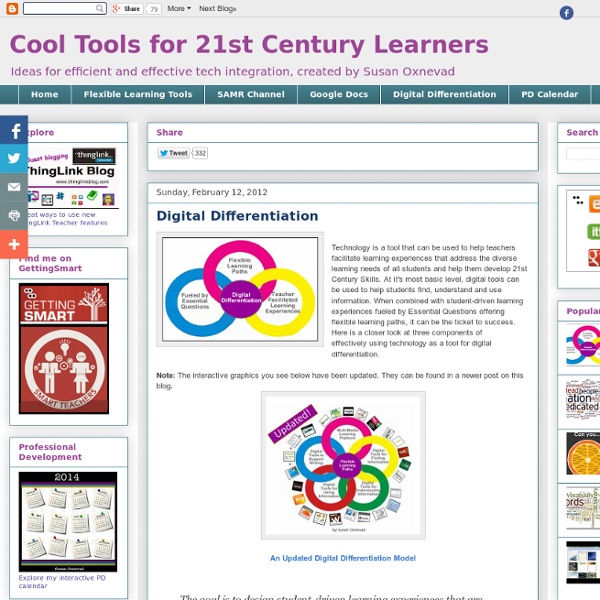Using Technology to Differentiate Instruction - TheApple.com
Resources >> Browse Articles >> Utilizing Technology Featured Author: Mrs.
Differentiation - tools, tips and resources
Differentiation is an important aspect of education. Students learn differently, have different needs, different backgrounds, different skills, different ability levels, different interests and more. As educators, we try to create engaging lesson activities that provide a variety of learning experiences and allow students to demonstrate their learning in different ways. Differentiation should occur in both how students learn and gain knowledge and skills, and in how they demonstrate and are assessed on what they have learned. “In the practice of education, differentiation is defined as working to address the abilities, interests, and needs (both perceived and real) of individuals.
An Updated Digital Differentiation Model
This is part of a Digital Differentiation model, my way i of weaving a web of flexible tools together for teaching and learning. To keep the model relevant, frequent updates are required, as new tools and trends emerge. To access the most current resources, please click on the tab at the top of this blog: Digital Differentiation - Current
Developing Independent Learners « Reflective Teacher and Learner
As part of the work I have been doing as part of my PLC group (see this previous post about PLC’s) I have been thinking a lot recently about different strategies that could be used to help pupils become better independent learners. The PLC group began our work by discussing what was meant by ‘independent learning’. Could you be an independent learner whilst working in a group? Could you seek help from other people and still be learning independently?
Design Thinking Is A Failed Experiment. So What's Next?
The decade of Design Thinking is ending and I, for one, am moving on to another conceptual framework: Creative Intelligence, or CQ. I am writing a book about Creative Intelligence, due out from HarperCollins in fall 2012, and I hope to have a conversation with the Fast Company audience on this blog about how we should teach, measure, and use CQ. Why am I, who at Business Week was one of Design Thinking's major advocates, moving on to a new conceptual framework? Simple.
The Differentiator
Try Respondo! → ← Back to Byrdseed.com
The Best Resources On Differentiating Instruction
My colleague Katie Hull-Sypnieski is leading a February 1st Education Week Webinar on differentiating instruction, and I would strongly encourage people to participate. Katie’s the best teacher I’ve ever seen…. In addition, Katie and I have co-authored a piece for Education Week Teacher on the topic that will be appearing there soon (it’s appeared: The Five By Five Approach To Differentiation Success), and an upcoming post in my blog there will be talking about it, too (that two part series has also appeared). I also did a second two-part series in Ed Week on differentiation.
Background Knowledge & Theory
The Basics Features of Project-Based Instruction Issues Raised About Project-Based Learning
What Teens Learn by Overcoming Challenges
Today's research in adolescent development validates a statement made over 100 years ago by the great African American educator, Booker T. Washington. He said, "I have learned that success is to be measured not so much by the position that one has reached in life as by the obstacles overcome while trying to succeed." We now know that learning to overcome challenges during adolescence develops initiative, an important characteristic of how we successfully pursue goals.
Frog Design: 3 Things Wile E. Coyote Teaches Us About Creative Intelligence
Bruce Nussbaum was right to close the book on Design Thinking. It is time to move on. Business never really got the message. What businesses continue to care about is innovation. While designers may think that innovation requires Design Thinking, that was an idea that never really stuck in the executive suite. Is "creativity" any different?
Centers: Effective Structures for Differentiation
Photo by Woodley Wonder Works This article is written by Katie Haydon, founder of Ignite Creative Learning Studio. Learn more about Ignite at IgniteCreativeLearning.com or the Ignite Facebook page.
Background and Contexts for Teaching Philosophies
Introduction – Contexts for Teaching Philosophies: The Teaching Portfolio A Teaching Philosophy often appears as part of a Teaching Portfolio, which has two main uses—summative and formative— both of which involve evaluation: Summative Evaluation is used to demonstrate the quality of a person's work for hiring and promotion purposes or for purposes of passing a course of study. Summative evaluation judges the outcome of one's work. Formative Evaluation is used as a means of assembling and examining one's work for the purposes of professional improvement. Formative evaluation seeks to identify areas to be improved and to suggest possible ways to make those improvements.
Discovering How to Learn Smarter
Big Ideas Getty By Annie Murphy Paul It’s not often that a story about the brain warms the heart.


